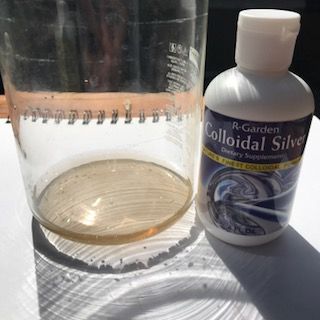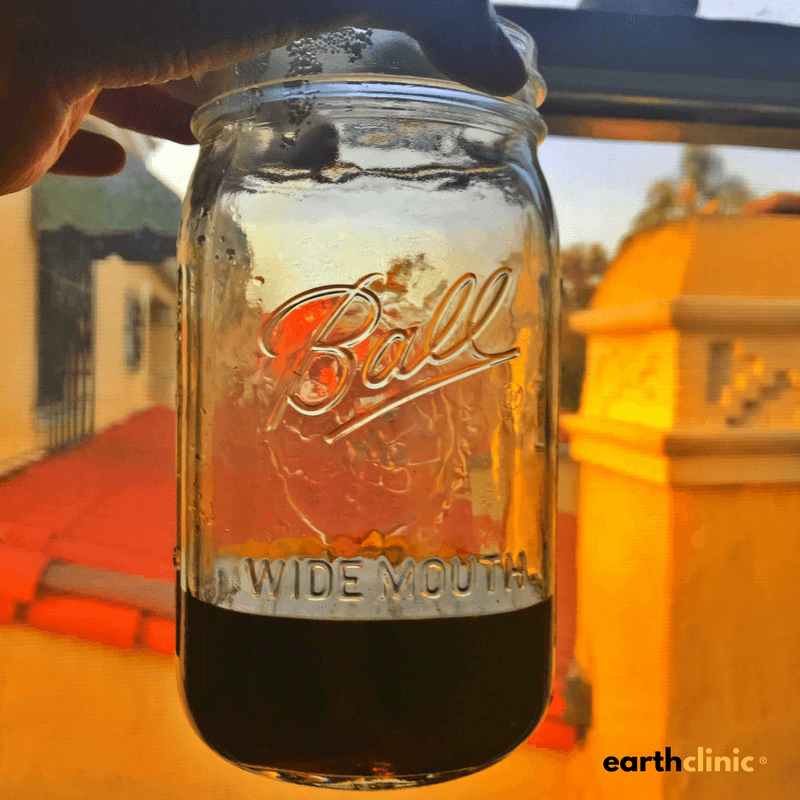Colloidal Silver Brand Comparisons
The label says it contains 8.8 ppm of 99.999% pure colloidal silver. The dosage on the bottle says 1 teaspoon daily. From posts I have been reading it sounds like 1 teaspoon is far too little to do any good? Also, if it tastes metallic, what does that mean? Is it a bad batch of CS? Thank you

In reply to Marty,
If the product was originally the color of water and clear and it also has a metallic taste, it likely is ionic silver. The little bit that can be seen in the picture does not look the color of water though.It looks like it has a little bit of golden color to it, but there is so little in the container it is hard to tell for sure. You said you left it in the sun and the sun exposure can partially reduce it which could explain why there is a little color to it. The fact that you say it has a metallic taste would suggest that it is not fully reduced and there is probably now a mix of colloidal and ionic silver. Many ionic silver products can contain a percentage of colloidal silver.
This product advertises itself as only 8.8 ppm. If that is the case, then that to could explain the lighter color. Colloidal silver that is close to the color of baby shampoo should be in the 20 ppm area. 8.8 ppm colloidal silver would be a lighter shade of yellow, while 40 ppm would be a much darker shade of yellow. Check the bottom of the jar and see if you can see what color the liquid is and also if there is any debris or sediment on the bottom of the jar. If so, it may not be up to 8.8 ppm anymore.
Art
(Alberta (Ca))
10/07/2017
I would like to ask about side effect of colloidal silver "sovereign silver " 10ppm. Can colloidal silver dry skin? Also I have put a drop in my eyelids and that is also very dry, I gargling it and my throat also feel dry. Can that be a side effect? Any advise please!!!
Convert Ionic Silver to Colloidal
Thank you for this site, great info here.
Tim
Yes, you can convert it if it really is ionic silver, but there is no practical way to know what it actually is.
To convert 500 ml of ionic silver to colloidal silver, you would have to add 10 drops of the Karo Light 50/50 (syrup/distilled water) mix to it and heat it to almost boiling. If it is 20 ppm ionic silver, then it should reduce to colloidal silver and should come close to the color of baby shampoo.If it were mine, I would take 1/4th of the bottle and add 3 drops of the 50/50 Karo Light to it and heat to near boiling to see what happens.
Art
(AL)
12/29/2023
Which is better to consume, ionic or collodial?
(Brisbane, Australia)
02/08/2018
Thank you for your suggestion. I will try 1/4 of the solution and experiment with your tips.
(Pa)
02/09/2018
★★★★★
Add 1/4 teaspoon of baking soda, 3 drops of Karo, and heat it to about 140 degrees (IE: it doesn't have to boil).
Since there is no issue with plateout, baking soda is sufficient.
Bill
(New York)
04/29/2021
Colloidal Silver Vs Ionic Silver
Ionic minerals are the naturally occurring form of minerals found in plants. Colloidal minerals are those that have not yet been converted into a bioavailable form for the human body. But you say reduced back to colloidal is better??
Star,
Silver as used for AgNPs is a metal.
Studies show that colloidal silver ("AgNP") is less toxic to normal human cells than ionic silver and colloidal silver is more efficient at getting Ag+ to where it needs to be inside of pathogens and also at helping to prevent Ag+ from entering cells indiscriminately as this can eventually lead to argyria with long term high dose use as Paul Karason did using an unknown form of silver that he made himself at home and took in large quantities every day. AgNPs release Ag+ when the silver particle comes in contact with different pathogens. The Ag+ then enters and destroys the pathogenic cell.
Art
(Abu Dhabi)
09/20/2022
This is all a gimmick. Nano silver is inert and needs to release the Ag+ ions in order to combine with the negative charge from the pathogens and deactivate them. It is much faster to use Ag+ in the first place. Converting Ag+ ions into nanosilver is like making tomato soup and then converting it back to whole tomatoes in order to eat it! If you are not aware of the science, please read it at this link https://www.truecolloidalsilverfacts.com/ The link is FULLY BACKED by science.
astrid,
I went to the link that you provided as scientific proof to support your claim, and there was not one scientific study to support the claim that you or the writer made. So basically, he is just giving his opinion of his understanding of the science. He is not a scientist, just the seller of a device that makes ionic silver.
I'm not saying you are right or wrong, but it seems that if you are going to make the claim, " FULLY BACKED by science," it seems like you should provide some scientific studies to support the claim or claims, in the writer's case. You didn't, and the writer of the article that you linked to, did not provide links to scientific studies that would support that claim.
Art
(Florida)
07/25/2023
Sorry but many studies show the 12 fold increase in efficiency and reduced human cell toxicity form nano colloids versus ions.
Please remember the human body has a digestive tract and many very strong chemicals that will react with ionic silver long before it can do any good.
(BA, oklahoma)
12/06/2023
A friend makes colloidal silver but it is clear, which I hear means it is not true colloidal but actually ionic. I was given some, can I reduce it to be actual colloidal?
EC: Yes. Please read Art and Bill's posts in the thread we attached your post to.
Hi David,
Studies suggest that colloidal silver is more effective, but anecdotal evidence suggests that ionic is effective also. The majority of newer studies use the colloidal form. I use the colloidal form and that is what my friends have used to good effect.
Art
Ionic Silver
I bought the silver maker from that site, and have been making my own. However, they day the silver can be clear, no colour. On here, it says there should be a yellowish colour. Also, it says if you get a metallic taste, it is ready. On here, I haven't read anyone saying about the taste.
I am now wondering if I have bought something that is only making ionic silver, not colloidal.
Does anyone know how I would find out whether what I bought is the real thing?
Thanks.
Hi Doreen,
If what you are making is clear and colorless with a metallic taste it is ionic silver. Colloidal silver at 20 parts per million, which is typically what is sold, should be yellow in color and not taste metallic. Generally, the higher the parts per million, the darker the color will be.
Ionic silver still works for most intended purposes, but studies suggests that colloidal silver nanoparticles are generally more effective and is what is used in studies.
Art
Ionic Silver
Jane,
It shouldn't be a problem unless he is doing it everyday of the year, but that could be a problem whether it is ionic or AgNPs as it could potentially create bacteria that is resistant to silver. It is really useful to have silver as a backup plan in cases of bacteria that have become resistant to antibiotics. Consider that colloidal silver is like a potent antibiotic or antiviral, would you take either of those everyday of the year?
Art
(USA)
07/25/2023
Art,
Can you please post a link that shows that bacteria can become RESISTANT to silver, never heard of that.
(Kentucky)
02/21/2023
@ Jane (Australia) Most the Colloidal Silver sold on the market is ionic silver. It has been thoroughly tested by the industry and causes no harm if used responsibly. I've been making and using it for over 30 years with no problems.
If you want to learn more, read:
https://thesilveredge.com/experts/
Colloidal Silver - The Natural Antibiotic Alternative by Zane Baranowski, CN
Gerald M.,
I have mentioned multiple times that I am not a fan of using colloidal silver everyday unless absolutely necessary, because silver is somewhat like an antibiotic in that with regular exposure, bacteria can build resistance to it. Here is one study showing as much :
Here is a relevant quote :
' Panacek et al43 showed that Gram-negative bacteria (including E. coli strains) can develop resistance to silver nanoparticles after repeated exposure but without any genetic changes. It resulted from phenotypic changes involving inhibition of the flagellum protein production. '
I have heard some people mention that they take CS everyday and that is why I have mentioned this aspect of silver previously on EC.
Art
Gerald M.,
This review may be more useful for you as it is a review of multiple studies confirming that various bacteria can definitely become resistant to colloidal silver:
https://www.frontiersin.org/articles/10.3389/fmicb.2021.652863/full
It has also been confirmed in animal studies.
Art
Ionic Silver
★★★★★



